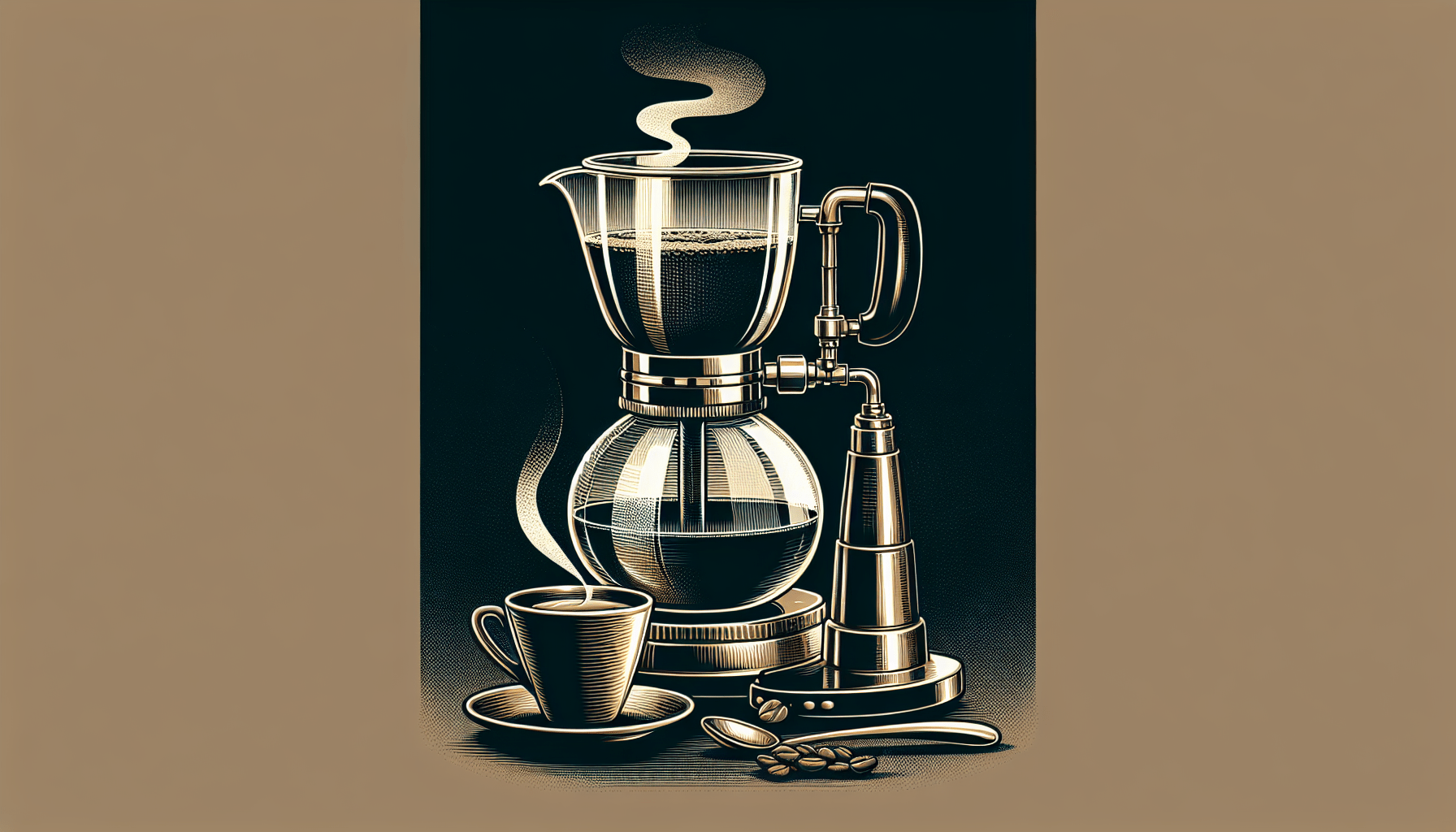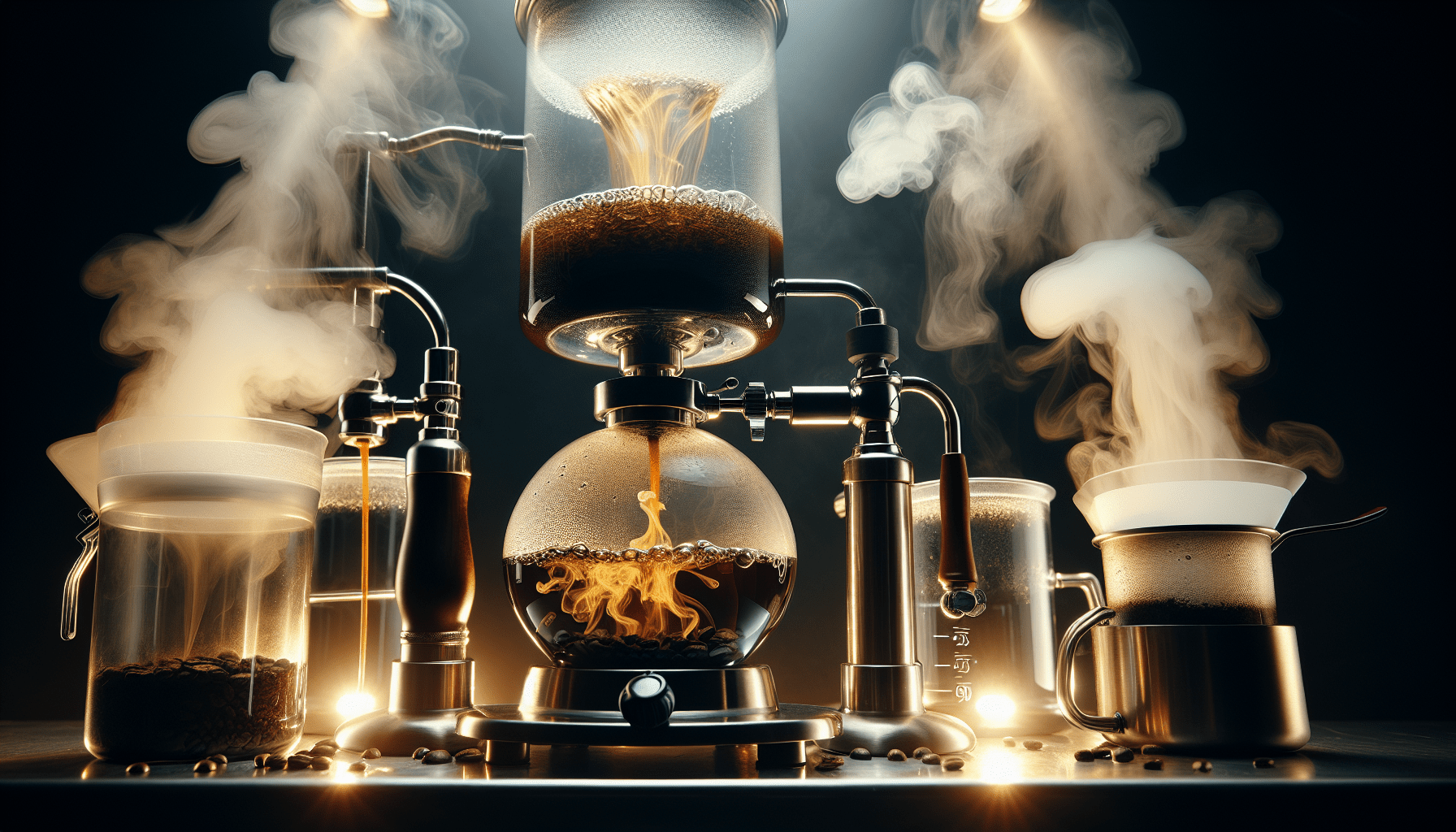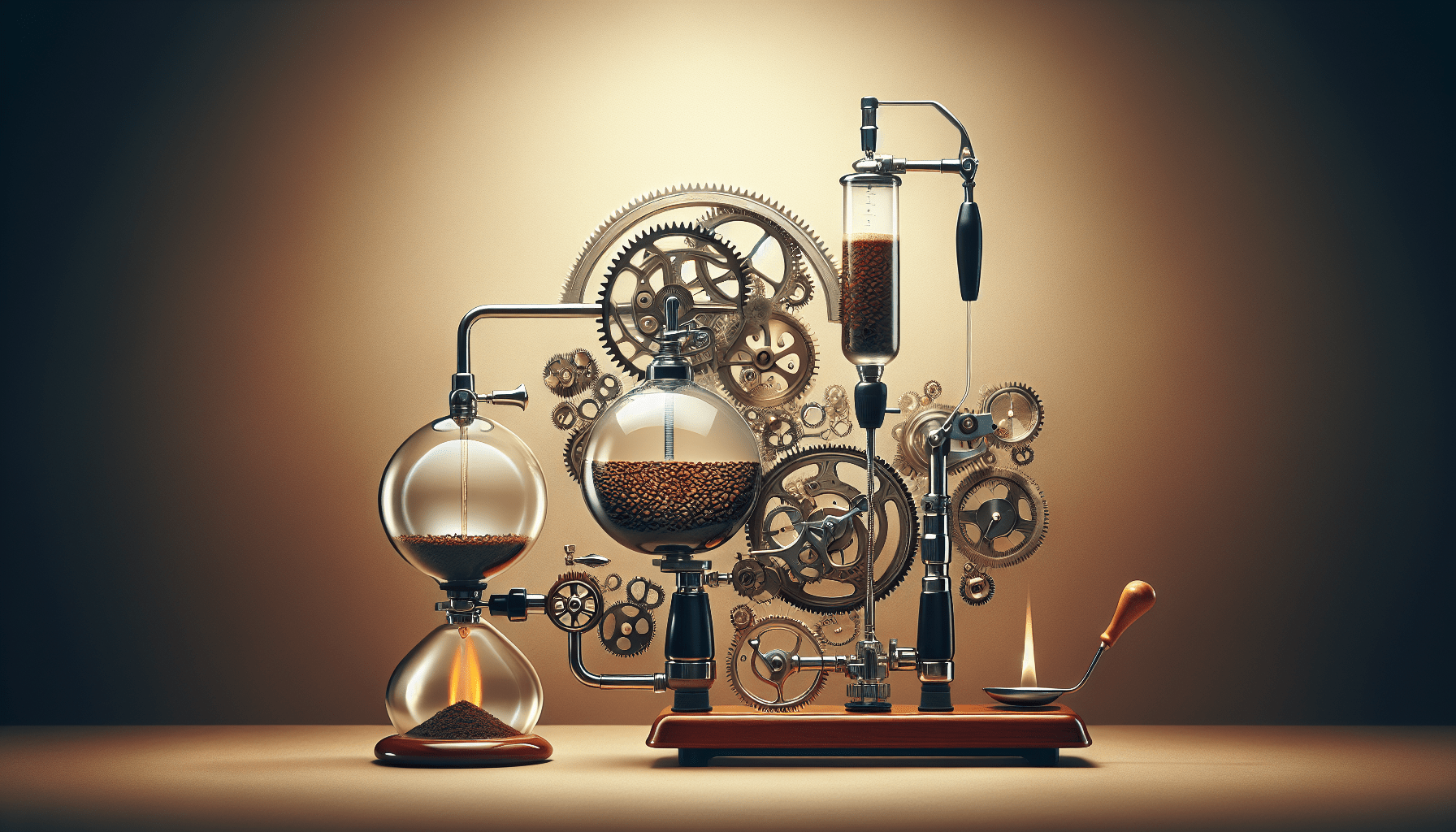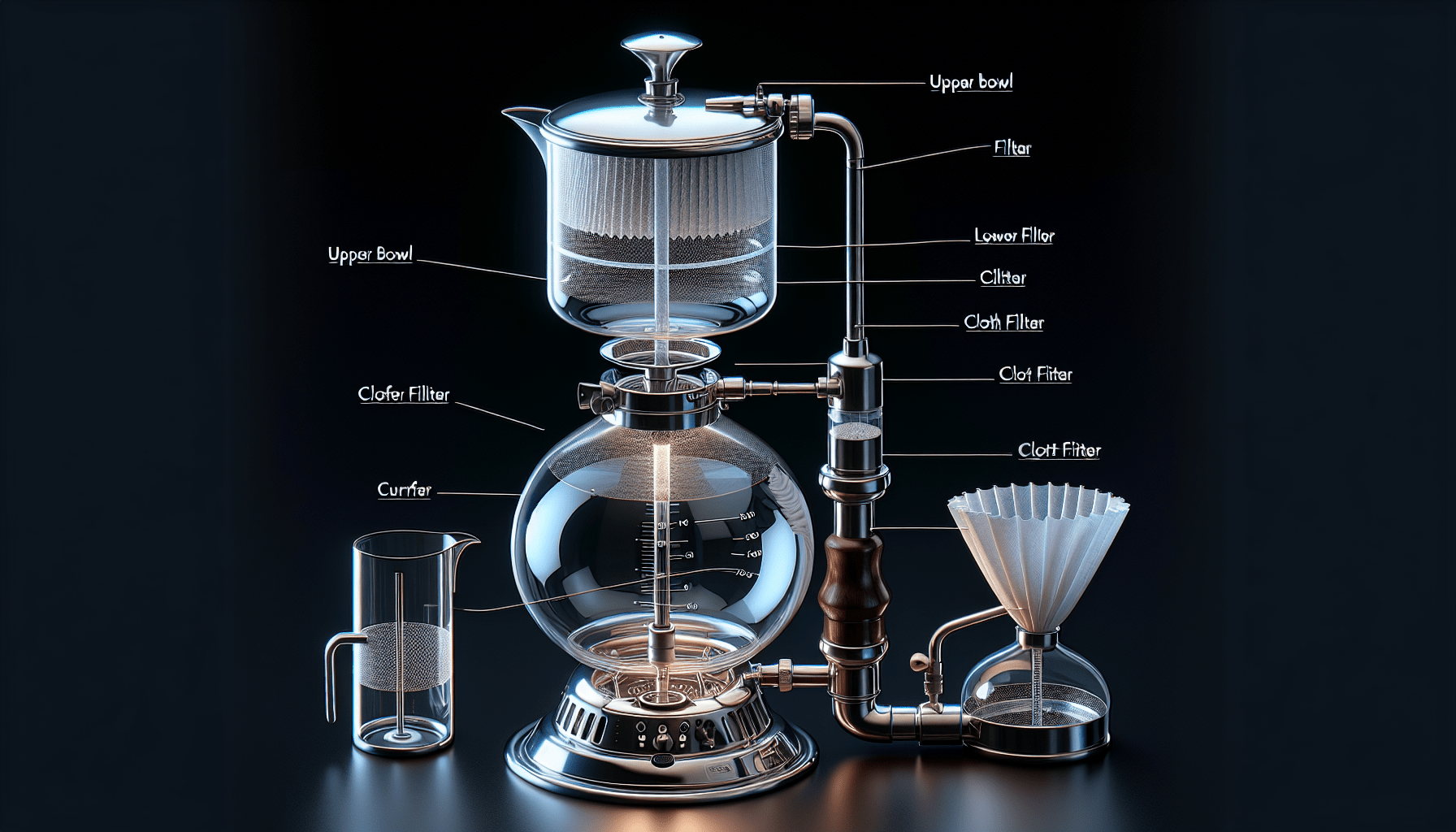Imagine waking up in the morning to the enchanting aroma of freshly brewed coffee. As you stumble into the kitchen, your sleepy eyes are met with a mesmerizing contraption known as a siphon coffee maker. It’s sleek, elegant, and promises to deliver a piping hot cup of joe like no other. But before you get lost in its elegance, you can’t help but wonder just how much coffee this exquisite machine can produce. Stay with us as we uncover the answer and unravel the mysteries of the typical siphon coffee maker.
What is a siphon coffee maker?
A siphon coffee maker, also known as a vacuum pot or vac pot, is a unique brewing device that combines principles of both immersion and filtration methods. It consists of two chambers – a lower chamber where water is heated, and an upper chamber where the brewed coffee collects. The process involves vapor pressure and gravity to extract flavors from the coffee grounds, resulting in a clean and flavorful cup of coffee.
Explanation of siphon coffee maker
A siphon coffee maker operates based on the principle of vapor pressure. Once the water in the lower chamber is heated, it creates steam which increases the pressure within the chamber. This pressure forces the water to rise into the upper chamber, where it comes into contact with the coffee grounds. As the heat is removed, the lower chamber cools down, creating a vacuum effect that pulls the brewed coffee back into the lower chamber, leaving the grounds behind.
How it works
To use a siphon coffee maker, you first add water to the bottom chamber and coffee grounds to the upper chamber. The bottom chamber is then heated, either with a burner or an electric heat source. As the water heats up, steam pressure builds and forces the water to rise up to the upper chamber. The coffee grounds are thoroughly saturated, allowing the extraction of flavors and aromas. After a designated brewing time, the heat source is removed, and the vacuum effect draws the brewed coffee back into the lower chamber, leaving the grounds behind. The coffee can then be poured and enjoyed.
Benefits of using a siphon coffee maker
Using a siphon coffee maker offers several benefits. Firstly, it produces an exceptionally clean and flavorful cup of coffee. The vacuum brewing process ensures that no sediments or oils from the coffee grounds make it into the final cup, resulting in a smooth and bright taste. Additionally, the visual appeal of the brewing process adds an element of excitement and entertainment. The siphon coffee maker also allows for precise control over variables such as water temperature, brewing time, and coffee-to-water ratio, enabling coffee enthusiasts to experiment and fine-tune their brewing techniques.
Understanding the brewing process
To fully understand the brewing process of a siphon coffee maker, it is essential to follow a step-by-step guide. Here is a simple breakdown of the process:
-
Add water to the bottom chamber: Fill the bottom chamber of the siphon coffee maker with the appropriate amount of water based on your desired coffee yield.
-
Add coffee grounds to the upper chamber: Place the upper chamber on top of the bottom chamber and add the desired amount of coffee grounds. The grind size should be medium to medium-fine, resembling sea salt.
-
Heat the bottom chamber: Place the siphon coffee maker on a heat source and apply heat to the bottom chamber. It is crucial to ensure that the heat source matches the size and design of your specific siphon coffee maker.
-
Observe the brewing process: As the water heats up, it will begin to rise to the upper chamber, infusing with the coffee grounds. The coffee will steep, extracting flavors and oils.
-
Remove heat source and stir: Once the desired brewing time is reached, remove the siphon coffee maker from the heat source and stir the coffee gently to ensure uniform extraction.
-
Experience the vacuum effect: As the lower chamber cools down, the brewed coffee will be drawn back down through the filter into the lower chamber, leaving behind the coffee grounds.
-
Serve and enjoy: Carefully separate the upper and lower chambers, and pour the brewed coffee into your cup or carafe. The result should be a clean, flavorful, and aromatic cup of coffee.
The importance of water-to-coffee ratio
Achieving the perfect water-to-coffee ratio is crucial in siphon coffee brewing. The ratio determines the strength and flavor profile of the resulting cup. The general rule of thumb is to use approximately 1 gram of coffee per 15-18 grams of water. However, personal preferences may vary, and experimenting with different ratios can help you fine-tune your preferred taste.
Factors influencing coffee yield
The amount of coffee produced by a siphon coffee maker can be influenced by various factors. Some of the key factors include:
-
Water capacity: The size of the bottom chamber determines the amount of water that can be used. Larger capacity siphon coffee makers can yield larger quantities of coffee.
-
Coffee grounds density: The amount of coffee grounds used will directly impact the strength and yield of the coffee. Adjusting the amount of coffee grounds can help achieve the desired coffee-to-water ratio.
-
Brew time: The length of time the coffee grounds are in contact with water affects the extraction and ultimately, the yield. Longer brew times generally result in higher coffee yields.
-
Filter type: Different filter types available for siphon coffee makers, such as cloth filters or metal filters, can affect the flow rate and, in turn, the overall coffee yield.
-
Technique and experience: Mastering the siphon brewing technique and understanding the nuances of the specific siphon coffee maker being used can lead to more consistent and optimized coffee yields.
Determining the coffee capacity of a siphon coffee maker
The coffee capacity of a siphon coffee maker can vary depending on factors such as size and model. Manufacturers typically specify the maximum recommended coffee capacity for each particular model. It is advisable to follow these guidelines to achieve optimal brewing results and avoid potential overflow or other issues.
Different sizes and models
Siphon coffee makers are available in various sizes and designs. These can range from smaller, single-serve models to larger, multi-cup capacities suitable for entertaining or commercial use. Some models even offer interchangeable chambers, allowing for versatile brewing options.
Variations in brewing capacity
The brewing capacity of a siphon coffee maker is primarily determined by the size of the bottom chamber and the recommended water-to-coffee ratio. Smaller siphon coffee makers may yield a single cup or serving, while larger models can produce several cups depending on the desired coffee strength and serving size.
Measurement units for coffee production
Coffee production from a siphon coffee maker is commonly measured in volume, such as fluid ounces or milliliters. Recognizing the specific units used by your particular siphon coffee maker is essential for accurately measuring water and coffee amounts.
Factors affecting the amount of coffee produced
Several factors can influence the amount of coffee produced by a siphon coffee maker. Understanding these factors can help enhance consistency and optimize coffee yields. Some of the key factors include:
Water capacity
The size of the bottom chamber determines the water capacity and, consequently, the potential coffee yield. Larger water capacities can result in greater coffee production.
Coffee grounds density
Adjusting the amount of coffee grounds used can directly impact the coffee yield. Increasing or decreasing the density of the coffee grounds can help achieve desired strengths and volumes.
Brew time
The duration of the brewing process affects the amount of coffee extracted. Longer brew times generally produce higher coffee yields.
Filter type
Different filter types, such as cloth or metal filters, can impact the flow rate and the final coffee yield. Experimenting with different filters can result in varying coffee production.
Technique and experience
Developing good brewing techniques and gaining experience with a specific siphon coffee maker can contribute to consistent and optimized coffee yields. Fine-tuning the brewing process can significantly affect the amount of coffee produced.
Average coffee yield from a typical siphon coffee maker
The industry standards and average coffee yield from a typical siphon coffee maker can vary. However, most commonly, a siphon coffee maker can produce between 8 to 32 fluid ounces (237 to 946 milliliters) of coffee per brewing cycle.
Industry standards
While there are no specific industry standards regarding coffee yield from siphon coffee makers, manufacturers often provide recommended coffee capacities for their respective models. These recommendations can guide users in achieving optimal results.
Examples of coffee yield measurements
A small siphon coffee maker with a water capacity of 20 fluid ounces (591 milliliters) might yield approximately 12 to 16 fluid ounces (355 to 473 milliliters) of brewed coffee. In contrast, a larger siphon coffee maker with a water capacity of 40 fluid ounces (1183 milliliters) could produce approximately 24 to 32 fluid ounces (710 to 946 milliliters) of coffee.
Range of coffee output
The range of coffee output from a siphon coffee maker ultimately depends on factors such as the chosen water-to-coffee ratio, brew time, and personal preference. By adjusting these variables, users can customize coffee output to suit their needs and taste preferences.
Calculating coffee-to-water ratio
The coffee-to-water ratio plays a crucial role in achieving the desired strength and flavor of the coffee. Calculating the ratio accurately is key to achieving consistent results.
Importance of ratio in coffee brewing
The ratio of coffee to water determines the strength of the brew, impacting its taste and intensity. A well-balanced ratio is vital for creating a well-extracted and flavorful cup of coffee.
Recommended ratios for siphon coffee makers
A common recommendation for siphon coffee makers is to use approximately 1 gram of coffee per 15-18 grams of water. However, personal preferences can vary, and it is advisable to adjust the ratio based on individual taste preferences.
Adjusting ratios for personal preference
For those who prefer a stronger cup of coffee, increasing the coffee dose or decreasing the water quantity can result in a bolder taste. Conversely, reducing the coffee dose or increasing the water amount can create a more mild and mellow cup. Experimentation and personal preference will guide the ideal coffee-to-water ratio.
Tips for maximizing coffee output
To maximize coffee output from a siphon coffee maker, consider implementing the following tips:
Optimizing water capacity
Choose a siphon coffee maker with a water capacity that aligns with your desired coffee yield. Larger capacities allow for greater production, while smaller capacities are ideal for single-serve or smaller quantities.
Choosing the right grind size
Ensure that the coffee grounds are of the appropriate size. A medium to medium-fine grind, similar to sea salt, is generally recommended for siphon coffee makers. Adjusting the grind size can affect the extraction process and thereby the coffee output.
Utilizing proper brewing techniques
Mastering the brewing techniques specific to siphon coffee makers can enhance coffee extraction and yield. Following the recommended steps, including proper heating, stirring, and timing, will optimize the brewing process.
Maintaining the siphon coffee maker
Regularly cleaning and maintaining the siphon coffee maker is crucial for optimal performance. Properly handling and storing the device, cleaning the chambers and filters, and descaling when necessary all contribute to consistent output and prolong the lifespan of the coffee maker.
Understanding variations in coffee strength
Achieving the desired coffee strength is subjective and can vary based on individual preferences. Siphon coffee makers allow for flexibility in adjusting variables other than the coffee-to-water ratio to achieve the desired strength.
Effects of different coffee-to-water ratios
Changing the coffee-to-water ratio is one way to adjust the strength of the coffee. Using a higher coffee dose or less water will result in a stronger brew, while using less coffee or more water will create a milder cup.
Determining personal preference
Personal preference plays a significant role in determining the desired coffee strength. Experimenting with different ratios, brew times, and grind sizes can help identify the strength that best suits individual tastes.
Adjusting other variables to achieve desired strength
Apart from the coffee-to-water ratio, other variables can be adjusted to achieve the desired coffee strength. Increasing the brew time, selecting a finer grind size, or even experimenting with water temperature can all affect the overall strength of the brew.
Common misconceptions about siphon coffee makers
There are several common misconceptions about siphon coffee makers that can be dispelled with accurate information.
Assumptions about limited coffee production
One misconception is that siphon coffee makers have limited coffee production capabilities. While they may not produce large quantities like drip machines or espresso makers, siphon coffee makers can still yield several cups of coffee per brewing cycle, depending on the size of the bottom chamber.
Comparisons with other brewing methods
Another misconception is that siphon coffee makers are inferior or less efficient compared to other brewing methods. However, the unique vapor pressure and vacuum brewing process of siphon coffee makers offer a distinct flavor profile that cannot be replicated with many other methods.
Dispelling myths with accurate information
By providing accurate information about the capabilities, brewing process, and benefits of siphon coffee makers, these misconceptions can be dispelled. Understanding the unique qualities of siphon brewing can help individuals appreciate and enjoy the distinct flavors it offers.
Exploring alternative brewing options
While siphon coffee makers offer a unique brewing experience, there are other methods to consider. Exploring alternative brewing options can help individuals find the brewing method that best suits their needs and preferences.
Other coffee brewing methods
Various brewing methods, such as pour-over, French press, Aeropress, and espresso, offer different qualities and flavors in the final cup of coffee. Each method brings its own nuances and characteristics, which can be explored to find the preferred brewing style.
Comparison of output between siphon and alternatives
Comparing the output from different brewing methods can help determine the brewing method that aligns with one’s desired coffee yield and taste preferences. Some methods may produce larger quantities, while others focus on brewing smaller, more concentrated cups.
Factors to consider when choosing a brewing method
When choosing a brewing method, factors such as desired coffee strength, time constraints, ease of use, and personal preferences should all be taken into account. Each brewing method has its own advantages and considerations, and finding the right fit will enhance the overall coffee experience.
In conclusion, siphon coffee makers offer a unique and visually appealing brewing experience. Understanding the brewing process, factors influencing coffee yield, and the importance of the coffee-to-water ratio are key to mastering the art of siphon coffee brewing. By utilizing the tips and information provided, you can maximize coffee output, adjust to desired strength, and dispel common misconceptions. Whether you decide to exclusively use a siphon coffee maker or explore alternative brewing methods, the ultimate goal is to enjoy a flavorful cup of coffee that suits your individual preferences.




